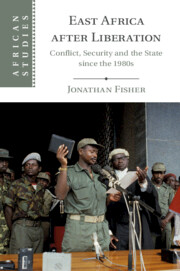Book contents
- East Africa after Liberation
- African Studies Series
- East Africa after Liberation
- Copyright page
- Dedication
- Contents
- Maps
- Acknowledgements
- Abbreviations
- Introduction
- Part I Insurgency
- Part II Liberation
- Part III Crisis
- 5 The Disintegration of the Liberation Coalition, 1998–2007
- 6 From Regional Conflict to Domestic Crisis
- Conclusion
- Bibliography
- Index
- African Studies Series
5 - The Disintegration of the Liberation Coalition, 1998–2007
from Part III - Crisis
Published online by Cambridge University Press: 24 February 2020
- East Africa after Liberation
- African Studies Series
- East Africa after Liberation
- Copyright page
- Dedication
- Contents
- Maps
- Acknowledgements
- Abbreviations
- Introduction
- Part I Insurgency
- Part II Liberation
- Part III Crisis
- 5 The Disintegration of the Liberation Coalition, 1998–2007
- 6 From Regional Conflict to Domestic Crisis
- Conclusion
- Bibliography
- Index
- African Studies Series
Summary
Chapter 5 explores the collapse of the EPRDF-PFDJ and NRM-RPF relationships between 1998 and 2001, until that point the main fulcrum of regional security policy for all four governing elites. The chapter explains how longstanding tensions within both pairings rose violently to the surface during this period. At the heart of both disagreements were feelings of superiority and inferiority dating back to affinities established during the struggle era and deep-seated militarism within each movement. These conflicts were, however, catalysed by changes in all four movements’ regional position in the post-liberation era. The intensely personal nature of EPRDF-PFDJ and NRM-RPF elite relations prior to this point, it is argued, rendered the subsequent violence and inter-state antagonism all the more acute and damaging, and the chapter underlines the significant regional repositioning the clashes forced all four states to undergo, and the unlikely regional alliances that this led to.
Keywords
- Type
- Chapter
- Information
- East Africa after LiberationConflict, Security and the State since the 1980s, pp. 193 - 232Publisher: Cambridge University PressPrint publication year: 2020



